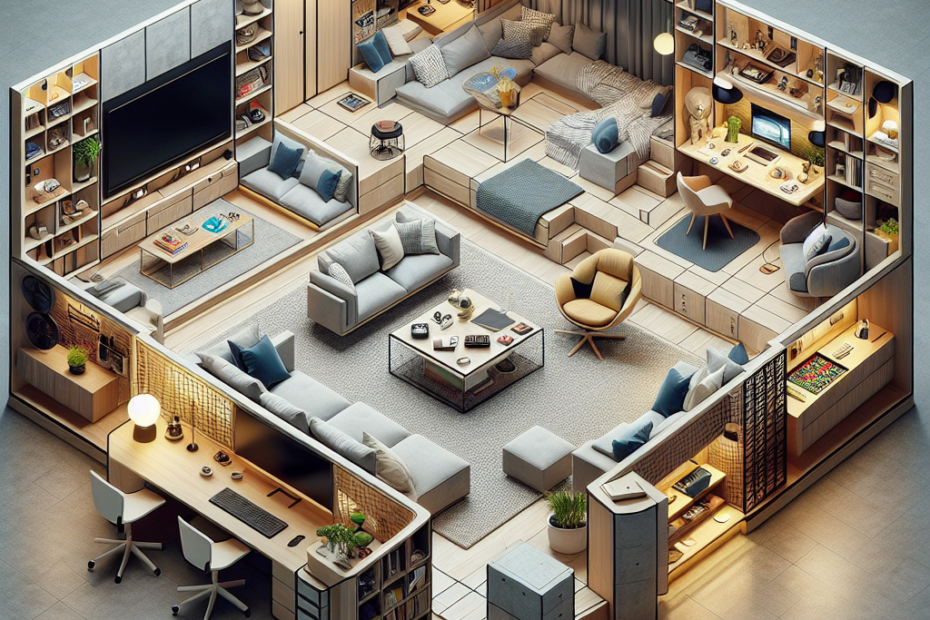“`html
Creating a Multi-Functional Living Room
In today’s ever-evolving world, where space can be both precious and limited, more families and individuals are seeking innovative ways to transform their living rooms into multi-functional spaces. This trend is largely driven by the increase in remote work, the need for home-based entertainment, and adaptability to changes in lifestyle. According to the National Association of Home Builders, 40% of remodelers reported working on projects that involved creating open or adaptable living spaces in 2022.
Understanding the Concept of a Multi-Functional Living Room
A multi-functional living room is a versatile space that serves more than one purpose. It’s a combination of a living room, home office, play area, or even a workout zone. These rooms are designed to maximize utility without sacrificing comfort or style.
Advantages of a Multi-Functional Living Room
Multi-functional living rooms offer numerous benefits:
- Space Optimization: They make the most out of available space, reducing clutter.
- Flexibility: These rooms can be easily adapted for various activities and changed as needs evolve.
- Cost-Effective: Combining different functionalities in a single room can reduce the need for additional furniture or remodeling costs.
Essential Tips for Arranging Furniture
When setting up a multi-functional living room, certain principles help achieve the desired outcome:
1. Identify Primary Functions
They should clearly define what functions the living room will serve. This helps in planning the layout effectively. For instance, if the living room serves as both a gathering area and a home office, space allocation becomes easier.
2. Use of Multi-Functional Furniture
Furniture that serves dual purposes is crucial. A sofa bed, an expandable dining table, or a storage ottoman can save space significantly. Floordaily reports that 55% of homeowners look for multi-functional furniture to accommodate their needs.
3. Zoning the Space
They should divide the room into different zones for each function. This can be done using area rugs or different lighting fixtures to define each space distinctively.
4. Vertical Thinking
Utilizing vertical space is often overlooked. Consider shelves, wall hooks, or tall cabinets that help in organizing without consuming floor space.
5. Maintain a Cohesive Aesthetic
While functionality is crucial, maintaining a cohesive look is equally important. Choosing a consistent color palette and coordinating decor ensures the room feels integrated and intentionally designed.
6. Incorporate Technology
Integrating technology can not only enhance utility but also streamline experiences. Features like built-in charging stations or adjustable lighting can add modern touches while adding convenience.
| Item | Purpose | Example |
|---|---|---|
| Sofa Bed | Seating & Sleeping | Convertible Couch |
| Expandable Table | Dining & Workspace | Extendable Dining Table |
| Storage Ottoman | Footrest, Storage & Table | Lift-Top Ottoman |
Common Missteps to Avoid
Even with careful planning, common mistakes include overcrowding the space, neglecting flow and movement, or mismatching styles that can disrupt the room’s harmony. They should prioritize practicality and comfort over excessive decor.
Key Takeaways
- Multi-functional living rooms cater to the need for adaptable and efficient spaces.
- Identify functions early to shape layout and furniture choices.
- Choose furniture that offers multi-purpose use and define space using zoning techniques.
- Embrace technology for added convenience.
- Maintain a cohesive look to ensure visual appeal and practicality.
FAQ
- What is a multi-functional living room?
It’s a space that serves multiple purposes, like living, work, play, or exercise, maximizing both utility and style. - How do they start designing a multi-functional living room?
They should identify the main functions the room will serve which helps in laying out the space and choosing appropriate furniture. - What are some essential furniture pieces?
Key pieces include a sofa bed, expandable table, and storage ottoman that provide flexibility and save space. - How can technology improve the functionality of a living room?
Features such as built-in charging stations and smart lighting can enhance utility and streamline experiences. - What are common mistakes to avoid?
Overcrowding the space, neglecting movement flow, and inconsistent aesthetic choices that break the harmony of the room.
Designing a multi-functional living room can seem challenging, but with careful planning, creativity, and attention to detail, it can transform into a delightful, efficient space that caters to varying needs without compromising comfort.
“`
